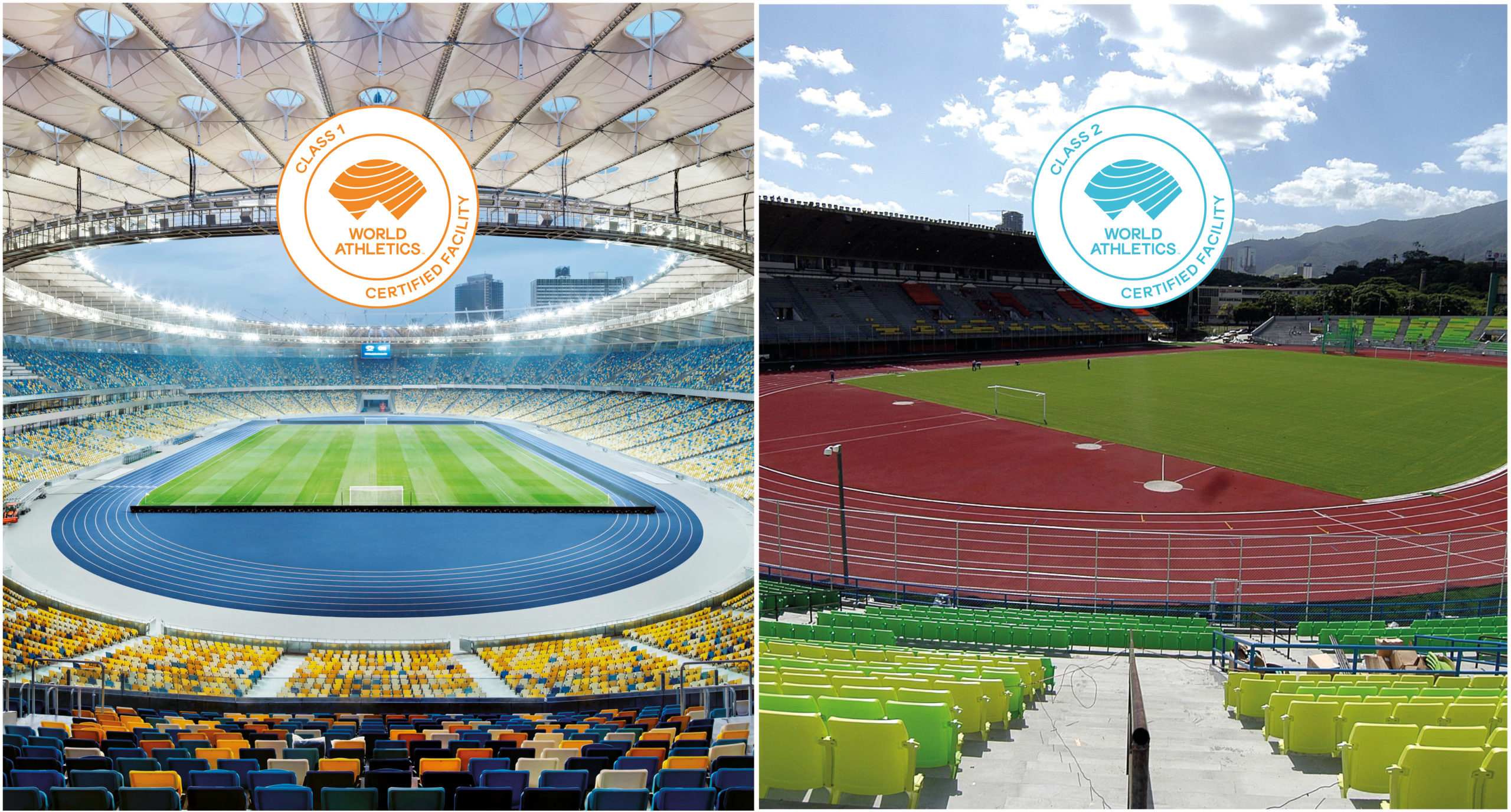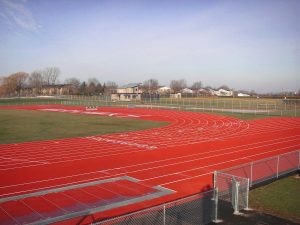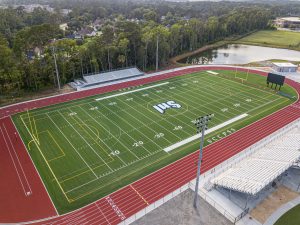As we have already seen, the type of competition to be held in the facility defines the required facility Category or CLASS. The following table lists the types and number of facilities required for each CLASS or category of facility:
WA – TRACK AND FIELD FACILITIES MANUAL 2019 CHAPTER 1 – GENERAL PLANNING ASPECTS
1.5.3 REQUIREMENTS FOR CONSTRUCTION OR FACILITY CATEGORIES
THE REQUIREMENTS IN TABLE 1.5.3 ARE THE MINIMUM REQUIREMENTS AND SHOULD ALSO BE CONSIDERED AS THE TECHNICAL REGULATIONS FOR EACH COMPETITION. FOR EXCEPTIONS SEE SECTION 1.5.4
| ITEM | COMPETITION FACILITIES | I | II | III | IV | V |
| 1 | 400 METRES OF TRACK AS DESCRIBED IN CHAPTER 2, WITH A MINIMUM OF 8 LANES ON THE OVAL AND 8 LANES ON THE STRAIGHT, SUITABLE FOR 100 M RACES AND 110 M HURDLES | 1A) | 1A) | 1A) | – | – |
| 2 | 400 METRES OF TRACK, WITH A MINIMUM OF 6 LANES ON THE OVAL AND 6 LANES ON THE STRAIGHT, SUITABLE FOR 100 M RACES AND 110 M HURDLES | – | – | – | 1B) | – |
| 3 | 400 METRES OF TRACK, WITH A MINIMUM OF 4 LANES ON THE OVAL AND 6 LANES ON THE STRAIGHT, SUITABLE FOR 100 M RACES AND 110 M HURDLES | – | – | – | – | 1B) |
| 4 | TRACK FOR OBSTACLE COURSES | 1 | 1 | 1 | – | – |
| 5 | LANES FOR HORIZONTAL JUMPS WITH A FALL ZONE AT BOTH ENDS | 2C) | 2C) | 1 | 2 | – |
| 6 | LANES FOR HORIZONTAL JUMPS WITH FALL ZONE AT ONE END | – | – | – | – | 1 |
| 7 | ZONES SUITABLE FOR HIGH JUMPS | 2 | 2 | 1 | 2 | 1 |
| 8 | LANES FOR POLE VAULTING AND POSSIBILITY OF FALL ZONE AT BOTH ENDS | 2C) | 2C) | 1 | 2 | – |
| 9 | LANES FOR POLE VAULTING AND POSSIBILITY OF FALL ZONE AT ONE END | – | – | – | – | 1 |
| 10 | SHARED DISCUS AND HAMMER THROWING FACILITY (WITH TANGENTIAL OR CONCENTRIC CIRCLES, PREFERABLY CONCENTRIC) | 1D) | 1D) | 1D) | 1E) | 1 |
| 11 | JAVELIN THROWING FACILITY | 2F) | 2F) | 2F) | 1 | 1 |
| 12 | SHOT PUT FACILITY | 2C) | 2C) | 2 | 2 | 1 |
| HEATING FACILITIES | ||||||
| 13 | 400 METRES OF TRACK, WITH A MINIMUM OF 4 LANES ON THE OVAL AND 6 ON THE STRAIGHT, MADE OF MATERIAL SIMILAR TO THE COMPETITION TRACK; JUMPING FACILITIES AND A SEPARATE ADJOINING AREA SUITABLE FOR JAVELIN, HAMMER AND DISCUS THROWING, AS WELL AS A MINIMUM OF 2 SHOT-PUT FACILITIES | * | – | – | – | – |
| 14 | 200 METRES OF TRACK, WITH A MINIMUM OF 4 LANES ON THE OVAL AND 4 LANES ON THE STRAIGHT (MINIMUM 60 METRES) AND MADE OF SYNTHETIC MATERIAL, OR AT LEAST 100 METRES OF A MIXED STRAIGHT AND CURVED SURFACE; JUMPING FACILITIES, MIXED ZONE FOR DISCUS, HAMMER, JAVELIN AND SHOT PUT | – | * | – | – | – |
| 15 | FOUR LANES OF TRACK ON THE STRAIGHT (MIN. 60 METRES), BUT PREFERABLY ALSO INCLUDES A TRAINING CURVE (SYNTHETIC SURFACE); JUMPING FACILITIES, COMBINED WITH AREA FOR DISCUS, HAMMER, JAVELIN AND SHOT PUT | – | – | * | – | – |
| 16 | ADJOINING PARK OR PLAYING SURFACE PREFERABLY WITH AT LEAST 4 LANES ON THE STRAIGHT (MIN. 60 METRES) | – | – | – | * | – |
| 17 | WITHOUT HEATING FACILITIES | – | – | – | – | * |
| OTHERS | ||||||
| 18 | AUXILIARY ROOMS AS DESCRIBED IN CHAPTER 4. MINIMUM AREA IN M2 | 250 | 200 | 150 | 200 | – |
| 19 | COMPLETE SPECTATOR FACILITY | * | * | * | * | -* |
B) AS PART OF A WA-IAAF CERTIFIED FACILITY
C) THE TWO FACILITIES MUST RUN IN THE SAME DIRECTION AND BE ADJACENT TO ALLOW SIMULTANEOUS COMPETITIONS OF TWO GROUPS OF ATHLETES UNDER SIMILAR CONDITIONS (ACCORDING TO FIGURE 2.5A)
D) COULD ACCOMMODATE AN ADDITIONAL DISCUS-ONLY FACILITY
E) A SECOND FACILITY OUTSIDE THE STADIUM IS RECOMMENDED FOR EVENTS THAT TAKE LONGER, BUT IN THE SAME THROWING DIRECTION
F) ONE AT EACH END OF THE ZONE WITH A MINIMUM RUN OUT LANE OF 33.5 METRES
#) PREFERABLY WITHIN THE SAME SPORTS COMPLEX, ADJOINING THE COMPETITION FACILITY. A MAXIMUM DISTANCE LIMIT, HOWEVER, IS NOT DEFINED. IF A FACILITY IS INTENDED FOR A MAJOR INTERNATIONAL EVENT, THE LOCATION OF THE STANDARD FACILITY AND THE HEATING FACILITY WILL BE DEFINED BY THE APPROPRIATE GOVERNING BODY.
*) REQUIRED
Although the different facility categories generally respect the specifications of the World Athletics Track and Field Facilities Manual for each type of facility, Section 1.5.4. indicates that organisers may sometimes make exceptions in the competition and training areas, provided that the valid technical regulations are respected.
As we can see, obtaining a Class 1 or Class 2 certification for the facility requires the capacity to handle multiple disciplines, including in duplicate at times, and the heating areas must also be taken into account. The above aspects include only what is necessary from the point of view of competition. Later, however, all sorts of construction aspects must also be considered, as with any project. When installing an athletics track, the subbase, drains, asphalt layer, etc. must be perfectly laid beforehand.
Obtaining a Class 1 certification for a facility thus currently requires a large investment, planning and a perfectly executed project. If you plan to have World Athletics (WA) certify the facility, we recommend having the whole project, from conception to supervision, accompanied by a professional with proven experience in and knowledge of the design of this type of sports venue.
Three basic concepts from this chapter:
- If you intend to have your facility certified Class 1 or Class 2, there are multiple aspects to consider, starting from the design phase.
- The synthetic surface is the cornerstone on which most disciplines are carried out
- Obtaining certification for a Class 1 or Class 2 facility requires warm-up areas in addition to the competition areas
In the next chapter, we will examine the types of synthetic surfaces that can be installed on an athletics track and the specific qualities of each system.
If in the meantime you are interested in learning more about CONICA’s systems for athletics tracks, please feel free to contact us or have a look at our Website: www.conicasports.com





